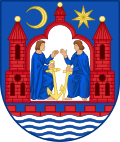Sabro, Denmark
Sabro has a sports club, football fields, a gym, grocery stores, hotels, restaurants, a church, two recreation centres, a dentist, a retirement home, a library, and a public day school, Sabro Korsvejskolen.
Onomastics
The name was recorded in about 1150 as Sahebroch and in 1386 as Saubro.
History
Sabro was originally one of the smaller villages in the area, with a few houses and farms south and west of Sabro Church.
After the road between Aarhus and Viborg (today Primærrute 26) was built through the area around 1890, a small settlement developed at the crossroads about 1 kilometre (0.62 mi) from the original village. In the mid-20th century the sogn (parish) councils of Borum-Lyngby, Lading and Sabro-Fårup (of which Sabro was part until 1 April 1970) decided to make this the location of a central school which was dedicated in 1964.
In the 1970s and 1980s the crossroads settlement and the original village merged, as part of a strong urban growth which has since continued eastwards, covering former agricultural land in the direction of the neighbouring village of Mundelstrup.
Notes
- ^ BY3: Population 1st January by urban areas, area and population density The Mobile Statbank from Statistics Denmark
External links
 Media related to Sabro at Wikimedia Commons
Media related to Sabro at Wikimedia Commons
